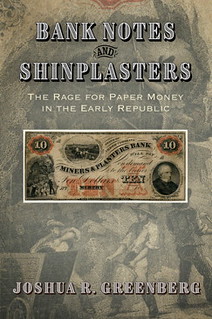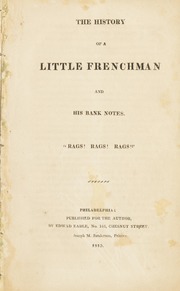
PREV ARTICLE
NEXT ARTICLE
FULL ISSUE
PREV FULL ISSUE
NEW BOOK: BANK NOTES AND SHINPLASTERSBob Leonard alerted me to this new book by Joshua R. Greenberg on banknotes and shinplasters in the U.S. Thanks! -Editor
"Prior to the Civil War, thousands of different, ornately engraved bank notes supplied most of the money in circulation. In marvelous detail, Joshua R. Greenberg takes us back to the anxieties of that era. He deftly examines how every single cash transaction was shot through with uncertainty and arbitrage, as ordinary citizens struggled with the perils of counterfeit notes, fluctuating exchange rates, and worthless paper. In his revealing reconstruction of a monetary world long lost to us, Greenberg ultimately explains how these mundane exchanges shaped the seismic political events of the day, from the Bank War to the Civil War. A splendid book."—Stephen Mihm, author of A Nation of Counterfeiters "Joshua R. Greenberg skillfully provides a history of how everyone in the early American republic pushed, pondered, purloined, politicized, and polemicized the thousands of material objects that circulated as their money. Historiographically significant and beautifully written, Bank Notes and Shinplasters will be of interest to anyone interested in the history of capitalism."—Jessica Lepler, author of The Many Panics of 1837: People, Politics, and the Creation of a Transatlantic Financial Crisis "In this persuasive and entertaining book, Joshua R. Greenberg shows that early republic Americans had their mind on their money and their money on their mind. They put bank notes—valuable and counterfeit, pristine and soiled—to mundane and surprising commercial, cultural, and political uses. Greenberg traces the circulation of these bills as material objects from bank vaults, to store tills, to consumers' pockets and back again. In so doing, he makes compelling use of them himself to register the contested economic and emotional meanings that these ubiquitous instruments had for Americans who held and passed them. I love this book." —Brian Luskey, author of On the Make: Clerks and the Quest for Capital in Nineteenth-Century America Before Civil War greenbacks and a national bank network established a uniform federal currency in the United States, the proliferation of loosely regulated banks saturated the early American republic with upwards of 10,000 unique and legal bank notes. This number does not even include the plethora of counterfeit bills and the countless shinplasters of questionable legality issued by unregulated merchants, firms, and municipalities. Adding to the chaos was the idiosyncratic method for negotiating their value, an often manipulative face-to-face discussion consciously separated from any haggling over the price of the work, goods, or services for sale. In Bank Notes and Shinplasters, Joshua R. Greenberg shows how ordinary Americans accumulated and wielded the financial knowledge required to navigate interpersonal bank note transactions. Locating evidence of Americans grappling with their money in fiction, correspondence, newspapers, printed ephemera, government documents, legal cases, and even on the money itself, Greenberg argues Americans, by necessity, developed the ability to analyze the value of paper financial instruments, assess the strength of banking institutions, and even track legislative changes that might alter the rules of currency circulation. In his examination of the doodles, calculations, political screeds, and commercial stamps that ended up on bank bills, he connects the material culture of cash to financial, political, and intellectual history. The book demonstrates that the shift from state-regulated banks and private shinplaster producers to federally authorized paper money in the Civil War era led to the erasure of the skill, knowledge, and lived experience with banking that informed debates over economic policy. The end result, Greenberg writes, has been a diminished public understanding of how currency and the financial sector operate in our contemporary era, from the 2008 recession to the rise of Bitcoin. Joshua R. Greenberg is the editor of Commonplace: the journal of early American life. Here's an excerpt - see more online. This looks like a great book. I ordered a copy. -Editor
Each of the Frenchman's subsequent transactions exposed the foreigner's inexperience with bank notes and shinplasters—paper money issued by nonbank entities like merchants or municipal corporations—because he could not discern which notes were good and which were worthless. In one typical episode, he offered to pay for a drink in a Bristol, Pennsylvania, tavern with a bill issued by the landlord of a Philadelphia hotel where he had previously stayed. His traveling companion explained that the hotelier, "in order to be in fashion, had also commenced Banker among the rest." Yet the Bristol landlord refused outright to accept the bill. The rejection upset the Frenchman; how was he to understand the difference between a note issued by a hotel operator or local postmaster and one from the Planters Bank of the State of Georgia? The problem for the Frenchman was that he did not have enough monetary knowledge to understand how bank notes and shinplasters actually worked, so he blindly received all of them equally. American paper money was more complicated than that. Though at first glance different bills might appear similar, some circulated at face value, others passed only with a discount, and a final group were accepted as currency only by their issuer. For more information, or to order, see:
To read The History of a Little Frenchman... on the Newman Numismatic Portal, see:
 Wayne Homren, Editor The Numismatic Bibliomania Society is a non-profit organization promoting numismatic literature. See our web site at coinbooks.org. To submit items for publication in The E-Sylum, write to the Editor at this address: whomren@gmail.com To subscribe go to: https://my.binhost.com/lists/listinfo/esylum All Rights Reserved. NBS Home Page Contact the NBS webmaster 
|

